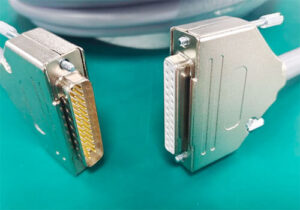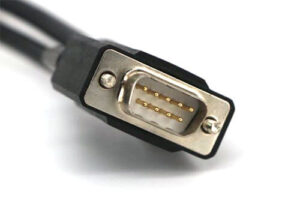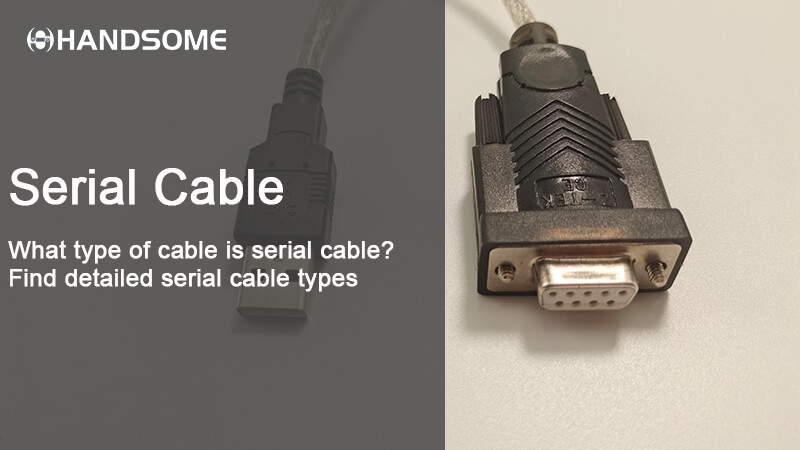Introduction of Serial Cables
Defining of Serial Cables
First of all, we need to understand what is the meaning of “serial interface”? Serial interface, also known as serial communication interface (usually referred to as COM interface), is an extension interface that uses serial communication.
It is one kind of interface. The data cable used for serial communication between devices is called a serial port cable.
A serial cable is a data cable that is connected to a serial interface and uses the serial data transmission mode. It is used for serial communication between peripheral devices and RS232 port.
The Pervasiveness of Serial Cables
In 1962, the smaller size of the personal computer has not yet appeared, when the teletypewriter and computer video terminals need to communicate with the modem, in order to standardize this communication process, the U.S. Electronic Industries Association (EIA) jointly with the various vendors released the EIA-RS-232A standard, in which the full name of the RS in English is Recommended Standard, is the recommended Standard means, “232” is the identification number; “A” indicates the first release.
After several years of practical application and improvement, in 1970, the EIA RS232 standard for the third revision, released the RS-232C standard. Where “C” indicates that it is the third revision (the second revision was B).
EIA-RS-232 referred to as 232 or RS232, the latest standard was released in 1997 EA-RS232F, but RS232C is the most widely used, the most well-known 232 standard, so people generally talk about RS232, referring to RS232C.
RS232 is a serial communication standard, referred to as the serial port, initially it has 22 wires, using DB25 connector, support synchronous and asynchronous serial interface.

The DB25 interface was initially widely used in personal computers because it was so popular that people also liked to call it a COM port, meaning communicationl port i.e. communication port, and when there were more than one communication ports, people used COM1,COM2 to refer to them.
With the development of technology, equipment manufacturers tend to smaller, lower-cost interface, therefore, the DB25 in the unused and the support of the special synchronization mode of the foot was removed, the formation of the current DB9 interface.

This DB9 interface connection is reliable, but also with shielding, was used as a computer and peripherals between the communication interface red for a while, although now personal computers have long been eliminated from this interface, the main reason is that it is too large, not in line with the computer miniaturization, lightweight needs, but in the connection of the higher reliability requirements of the field of industrial control, the DB9 interface is still widely used, and sometimes not as a physical interface for RS232. RS232 physical interface, but as other communication protocols such as CAN communication interface.
Therefore, the development to the present, RS232C and its corresponding physical interface DB9 in the personal computer has not been applied, in the industrial control board RS232 is also used less, and generally only to TX, RX and GND the three wires and omit the other control cables, but the DB9 interface is still widely used.
Types of Serial Cable
RS-232 Serial Cable
- USB2.0 to RJ Cable
- USB2.0 to D-sub Cable
- USB2.0 to DIN Cable
- USB2.0 to Audio Cable
- USB2.0 to HSG Cable
- USB2.0 to Mini Micro USB Cable
- USB2.0 to Open Wire Cable
- Type C to DB9 Cable
- Type C to RJ Cable
- Micro USB to D-sub Cable
RS-485 Serial Cables
- USB2.0 to RJ Cable
- USB2.0 to D-sub Cable
- USB2.0 to LXR Cable
- USB2.0 to Audio Cable
- USB2.0 to HSG Cable
- USB2.0 to Mini Micro USB Cable
- USB2.0 to Open Wire Cable
- Type C to DB9 Cable
- Micro USB to D-sub Cable
RS-422 Serial Cable
TTL Serial Cable
- USB2.0 to RJ Cable
- USB2.0 to D-sub Cable
- USB2.0 to DIN Cable
- USB2.0 to Audio Cable
- USB2.0 to HSG Cable
- USB2.0 to Mini Micro USB Cable
- USB2.0 to Open Wire Cable
- Type C to DB9 Cable
- Micro USB to D-sub Cable
Console Cable
- USB2.0 to RJ45 Console Cable
- Type C to RJ45 Console Cable
- Micro to RJ45 Console Cable
Serial Cable Compatibility
Wiring Standards:
Serial cables use different wiring standards, such as DTE (Data Terminal Equipment) and DCE (Data Communications Equipment) configurations. DTE devices, like computers, usually have a female connector, while DCE devices, like modems, typically have a male connector. Ensure that your cable’s wiring corresponds to the roles of the connected devices.
Signal Levels:
RS-232 serial communication uses different signal voltage levels, such as RS-232C, RS-232D, and RS-232E. These signal levels may vary slightly between devices, so it’s important to use a cable that is compatible with the signal voltage levels of your equipment.
Null Modem Cables:
In some cases, you may need a null modem cable to connect two devices directly without a modem or other intermediary. Null modem cables cross over the transmit and receive lines to enable direct communication between two DTE devices.
Adapter Cables:
If you need to connect devices with different types of connectors, you can use adapter cables to bridge the gap. For example, if one device has a DB9 connector and the other has a DB25 connector, you can use a DB9-to-DB25 or DB25-to-DB9 adapter cable.
Cable Length:
Be mindful of the cable length. Longer cables can lead to signal degradation and communication errors. Use the appropriate cable length for your specific application.
Baud Rate and Communication Settings:
Ensure that the devices you are connecting are configured with compatible baud rates, data bits, stop bits, and parity settings for successful serial communication.
In summary, the compatibility of serial cables depends on factors such as connector types, gender, wiring standards, signal levels, and the specific devices you want to connect. Always verify the cable’s specifications and the requirements of your equipment to ensure a successful connection. If in doubt, consult the documentation provided by the device manufacturers or seek advice from technical experts.
Practical Applications of Serial Cable
Legacy Equipment Connectivity: Many older electronic devices, such as industrial machinery, manufacturing equipment, and scientific instruments, still use serial ports for communication. Serial cables are used to connect modern computers to these legacy devices for data monitoring, control, and configuration.
Serial Console Connections: Serial cables are commonly used to establish console connections to networking equipment like routers, switches, and firewalls. Network administrators use serial cables to access the device’s command-line interface for configuration and troubleshooting, especially in situations where the network isn’t operational.
Point-of-Sale (POS) Systems: Some POS systems, especially older ones, use serial communication for connecting cash registers, barcode scanners, and receipt printers. Serial cables are used to ensure proper communication between these devices and the central POS system.
Gaming and Retro Computing: Enthusiasts of retro computing and gaming often use serial cables to connect vintage computers, consoles, and peripherals. These cables allow for data transfer, multiplayer gaming, and connecting classic hardware to modern systems.
Industrial Automation: Serial communication plays a vital role in industrial automation systems. PLCs (Programmable Logic Controllers), HMI (Human Machine Interface) devices, and sensors often use serial communication for real-time monitoring and control of industrial processes.
Telemetry and Data Acquisition: In scientific research and remote monitoring applications, serial cables are used to connect data acquisition equipment to computers for collecting data from sensors, instruments, and remote monitoring stations.
GPS Devices: Some GPS receivers and navigational equipment still use serial connections to communicate with computers or other devices. Serial cables are used to transfer GPS data for mapping and geolocation applications.
Embedded Systems Development: Serial cables are commonly used in the development and debugging of embedded systems. Microcontrollers, single-board computers, and development boards often feature serial ports for programming and serial debugging.
Automotive Diagnostics: In the automotive industry, On-Board Diagnostics (OBD) systems often use serial connections to communicate with diagnostic tools and software for vehicle diagnostics and troubleshooting.
UPS (Uninterruptible Power Supply) Management: Some UPS units have serial ports for monitoring and managing power backup systems. Serial cables are used to connect UPS units to computers for configuring settings and monitoring power status.
Home Automation and IoT: In some older home automation systems and IoT devices, serial communication is used for device control and data exchange. Serial cables may be used to connect these devices to a central controller or gateway.
While serial cables have become less common in consumer applications, they remain essential in specific industrial and technical fields. When working with serial cables, it’s important to consider compatibility, baud rates, and other communication settings to ensure reliable data exchange between devices.
